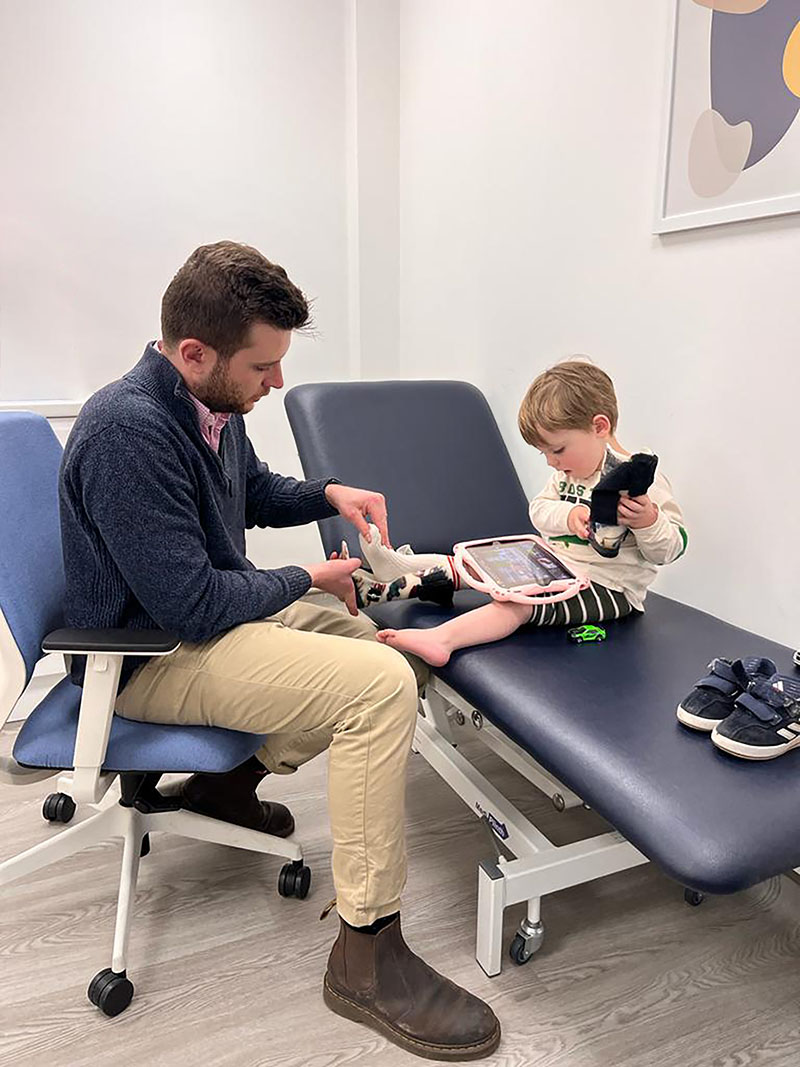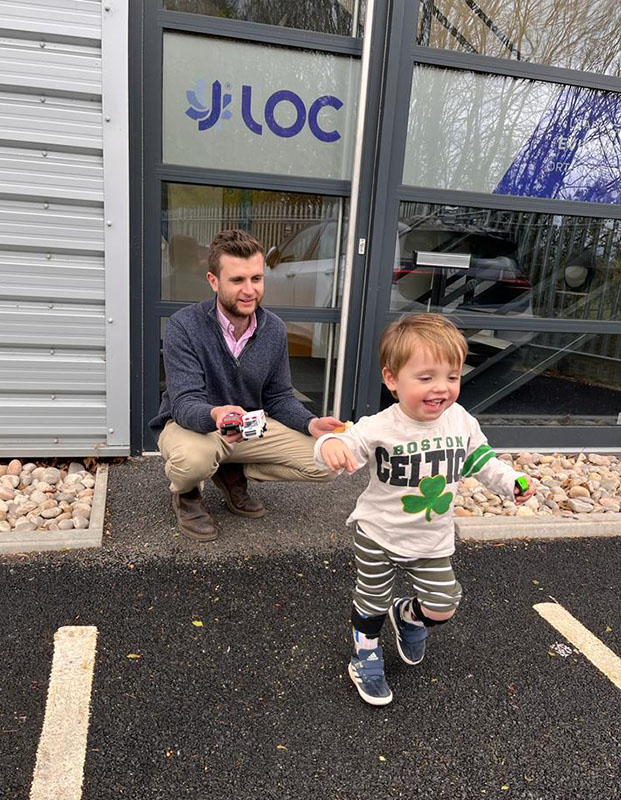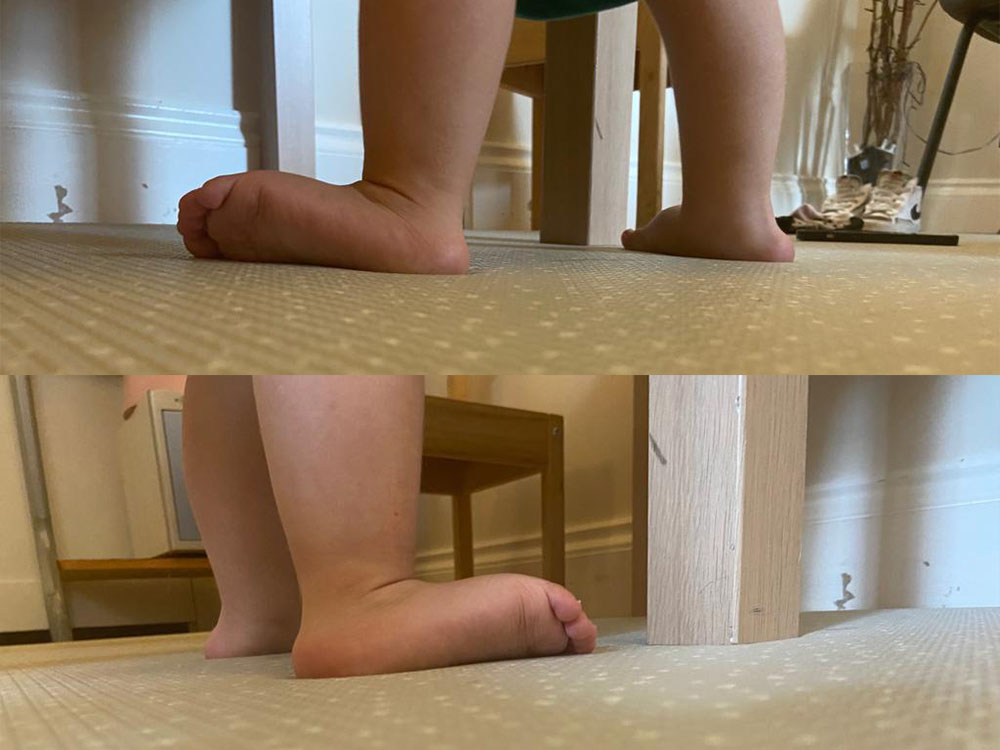
Clinician Connor Mumford fitting Gus's new AFOs in our Cambridge clinic
12 June 2023
Gus could not walk because of his severe hypermobility. Now he’s playing football thanks to bespoke AFOs from the London Orthotic Consultancy.
Hypermobility describes a condition where a child has more than the normal range of movement in some or all of the joints in their body. It’s extremely common in children, however there is a vast difference in the severity of symptoms. At one end of the scale are those who are ‘double jointed’ and at the other are babies like Gus.
Gus was a ‘Covid baby’, meaning he was born at the height of the pandemic. This had an impact on how little routine NHS care was available; there were no visits from a health visitor for example. Harriet, his mum, recalls: “He was super bendy. Because of this, he was slow to sit up and pull himself up to a standing position.” By the time they were able to see a GP, there was a pronounced backlog in onward referrals to physiotherapists which was the GP’s original recommendation. Harriet decided to seek further advice and turned to an osteopath who told her that Gus’s symptoms were some of the most severe she had seen. His soles pointed out to the side and his feet very distended. The osteopath recommended that Harriet should seek out a specialist orthotist and recommended LOC.
Gus was first assessed by Connor Mumford, who heads up LOC’s Cambridge clinic, just before he was two years old. He could not walk. It was clear to Connor that Gus’s feet and ankles needed considerable support, so he prescribed bespoke AFOs that were untypically long, stretching right up to the knee. Harriet says: “Connor was amazing, very clear about what he was going to do and able to tell me in non-jargon what we could expect from his recommended treatment. He was also extremely encouraging, reassuring us that Gus would get better. And when it got to the fitting, he paid so much care and attention to make sure that Gus was as comfortable as possible in these new things he was going to have to wear.”

Connor Mumford and Gus at LOC Cambridge
Fast forward a couple of weeks and mum Harriet noted a transformation, “There is no stopping him now, he is now even able to play football, which is really difficult to believe, the improvement has been so rapid.”
Harriet was also grateful to Connor for suggesting that she get Gus checked out by a specialist pediatrician just in case he had Cerebral Palsy. "Connor explained to me that there were some similar symptoms and thought it was worth just making sure. It was funny because the NHS physio knew Connor and I got a sort of retrospective recommendation which I no longer needed! And Gus got the all clear which was wonderful news.”
What does the future hold? The AFOs are supporting Gus’s lower limbs so that his muscles can strengthen naturally as he plays and exercises with children of the same age, something that was impossible before. Gus will be reviewed periodically at LOC’s new Cambridge clinic which has a Gait Laboratory that will help Connor monitor Gus’s progress and fine-tune his AFOs as appropriate. In time Gus will progress to just needing insoles to support his feet.
Contact us if you would like to know more about our bespoke orthotics and treatment for hypermobility.

Gus's hypermobility meant the soles of his feet pointed outward when standing.
An AFO is an Ankle Foot Orthosis which as the name would suggest encompasses the ankle and foot. The objective is to control the position and movement of the ankle. AFOs are used to support weak limbs; they can also be used to immobilise the ankle and lower leg to correct foot drop. When set up correctly they can also have a great influence on the knee and hip joints. They are the most commonly used Orthoses.
The length of time that one needs to wear an AFO very much depends on the condition being treated. If it is a long-term condition like cerebral palsy or post-polio syndrome it is likely to be years as the condition cannot be cured. Your orthotist will advise you.
A patient’s comfort in their AFO is vital for compliance with the prescribed wearing regime.
So there are a number of steps the orthotist should take to ensure a comfortable fit: the patient’s heel should fit fully into the heel cup without excess space, the contours of the plantar surface of the AFO should match the patient’s foot, for children there needs to be up to half an inch growth room in the toe shelf length. At LOC we use our Gait Laboratories at our Kingston and Manchester clinics to fine-tune our bespoke orthotics.
The most flexible type of AFO is a Dynamic Ankle Foot Orthosis (DAFO). It is thin and provides flexible support to the foot and ankle.
The cost of an AFO is dependent on the type of AFO that has been prescribed and the material that it has been made with. Carbon fibre will be more expensive than metal or plastic for example. LOC’s bespoke AFOs cost can be found on our Orthotic Prices page.
The simple answer is: yes they can. However one has to be sensible and look for wide-fitting trousers/jeans preferably of light and thin material.